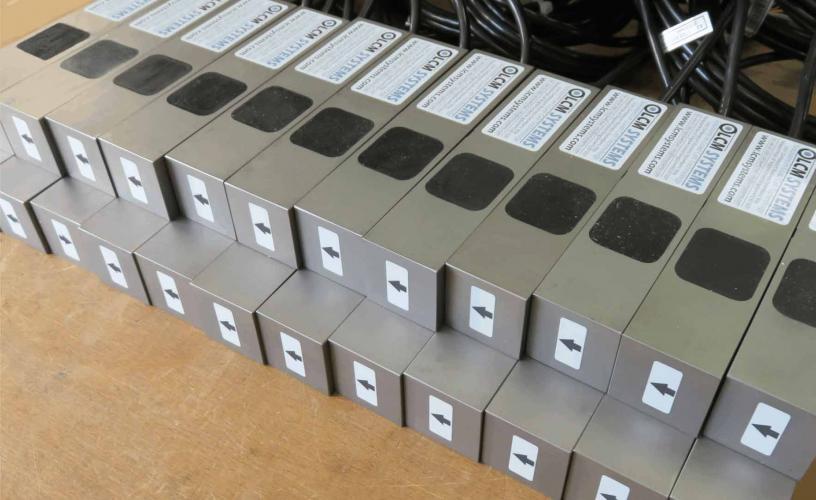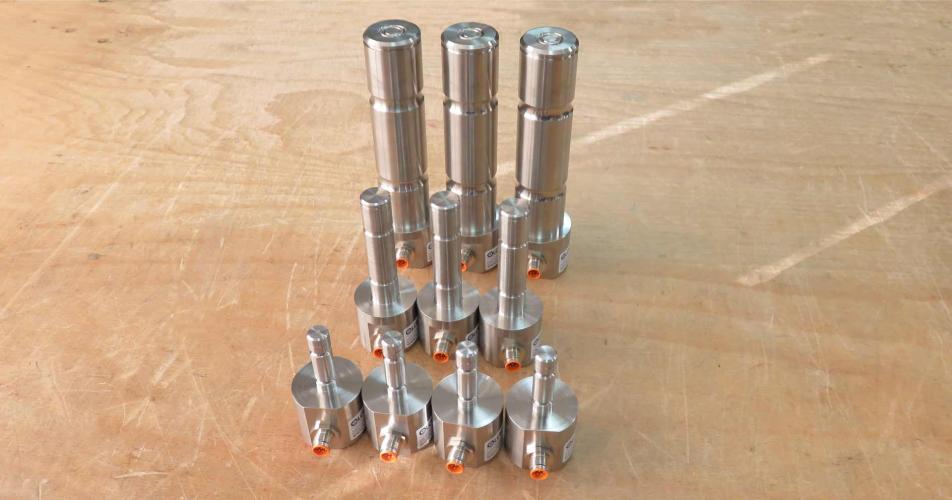- Inicio
- Sobre
- Productos
- TIENDA
- Mercados
- Aplicaciones
- Soporte
- Contacto
- Noticias
Aplicación de Células de carga: Aprovechar la precisión en todas las industrias
Células de carga son herramientas indispensables en un sinfín de Aplicaciones de diversas industrias, ya que permiten medir con precisión la fuerza, el peso y la presión. Exploremos tres áreas clave en las que Células de carga desempeña un papel crucial: el pesaje industrial, la industria aeroespacial y de defensa, y las pruebas de automoción.
Pesaje industrial:
Células de carga son la columna vertebral de los sistemas de pesaje industrial, ya que proporcionan una medición precisa y fiable de los pesos en diversos procesos de fabricación y logística. Desde sencillas básculas de sobremesa hasta complejos sistemas de báscula puente, Células de carga garantiza la medición precisa de materias primas, productos acabados Productos y productos a granel. Industrias como la fabricación, la logística, la agricultura y el procesamiento de alimentos confían en Células de carga para la gestión de inventarios, el control de calidad y el cumplimiento de las normas reglamentarias. Tanto si se trata de pesar ingredientes en la producción farmacéutica como de controlar el flujo de materiales en los almacenes, Células de carga optimiza la eficiencia y la precisión en el pesaje industrial Aplicaciones.
Gestión de inventarios: Células de carga se utilizan en los sistemas de gestión de inventarios para medir y controlar con precisión las cantidades de materias primas, componentes y productos acabados Productos en almacenes e instalaciones de producción. Al proporcionar datos de peso en tiempo real, Células de carga permite a las empresas optimizar los niveles de inventario, evitar la falta de existencias y minimizar los costes de transporte.
Dosificación y mezcla: En industrias como la alimentaria, la farmacéutica y la química, la medición precisa de ingredientes y aditivos es fundamental para mantener la calidad y consistencia del producto. Células de carga integrado en equipos de dosificación y mezcla garantiza la dosificación exacta de materiales, lo que permite formular recetas con precisión y minimizar los residuos.
Manipulación de materiales a granel: Células de carga se emplean en cintas transportadoras, básculas de tolva y sistemas de pesaje de silos para medir los caudales y las cantidades de materiales a granel, como granos, áridos y polvos. Al medir con precisión el caudal de material, Células de carga facilita la eficacia de los procesos de producción, optimiza la reposición de existencias y garantiza el cumplimiento de la normativa en materia de peso.
Control de calidad: Células de carga se utiliza en procesos de control de calidad para realizar comprobaciones de peso, inspecciones del nivel de llenado y pruebas de integridad del envase en Productos antes de su envío a los clientes. Al verificar el peso y las dimensiones del producto, Células de carga ayuda a identificar discrepancias, evitar problemas de llenado insuficiente o excesivo y mantener los estándares de calidad del producto.
Seleccionar Células de carga para el pesaje industrial puede ser complicado. Consulte aquí algunas de las mejores prácticas .

Aeroespacial y Defensa:
En los sectores aeroespacial y de defensa, la medición de precisión es fundamental para garantizar la seguridad, la fiabilidad y el rendimiento de las aeronaves, las naves espaciales y los sistemas de defensa. Células de carga desempeña un papel vital en varios Aplicaciones, incluidos los ensayos estructurales, los ensayos en vuelo y los equipos en tierra Soporte .
Pruebas estructurales: En ingeniería aeroespacial, Células de carga forma parte integral de las pruebas estructurales de componentes de aeronaves y naves espaciales. Células de carga se utiliza para aplicar fuerzas controladas y medir las deformaciones, tensiones y flexiones resultantes durante las pruebas estáticas y dinámicas. Al simular las condiciones de funcionamiento del mundo real, Células de carga ayuda a los ingenieros a validar diseños, verificar la integridad estructural e identificar posibles modos de fallo, garantizando que las aeronaves y naves espaciales cumplan los estrictos requisitos de seguridad y rendimiento.
Pruebas de vuelo: Células de carga desempeñan un papel crucial en los ensayos en vuelo de aeronaves y vehículos aeroespaciales, en los que la medición precisa de las fuerzas y momentos aerodinámicos es esencial para evaluar las características y el rendimiento del vuelo. Células de carga se instalan en modelos de túneles aerodinámicos, artículos de ensayo en vuelo y equipos en tierra Soporte para medir la sustentación, la resistencia, el empuje y otros parámetros aerodinámicos. Al proporcionar datos en tiempo real durante las pruebas de vuelo, Células de carga permite a los ingenieros evaluar la estabilidad de la aeronave, su maniobrabilidad y la eficacia del sistema de control, orientando las mejoras en el diseño y la configuración.
Equipos de tierra Soporte : En defensa Aplicaciones, Células de carga se utilizan en diversos equipos de tierra Soporte para garantizar la manipulación y el funcionamiento seguros de aviones, helicópteros y vehículos Soporte . Células de carga se integran en gatos de aviones, ganchos de remolque y ganchos de carga para medir y controlar las cargas durante las operaciones de mantenimiento, revisión y carga. Al controlar las cargas con precisión, Células de carga ayuda a evitar sobrecargas, desequilibrios y daños estructurales, garantizando la disponibilidad operativa y el éxito de la misión.
Pruebas de cargas útiles y equipos: Células de carga se emplean en las pruebas y la calibración de cargas útiles, equipos y subsistemas para los sectores aeroespacial y de defensa Aplicaciones. Células de carga miden las fuerzas y los pares ejercidos por las cargas útiles durante su integración, despliegue y funcionamiento. Al verificar el cumplimiento de los requisitos de peso y equilibrio, Células de carga garantizan el funcionamiento seguro y fiable de los sistemas aeroespaciales y de defensa en entornos de misión crítica.
Aquí encontrará más información sobre el papel de Células de carga en los ensayos aeroespaciales .

Pruebas de automoción:
Las pruebas de automoción se basan en gran medida en Células de carga para evaluar el rendimiento, la durabilidad y la seguridad de vehículos y componentes de automoción. Células de carga se utiliza en diversos escenarios de pruebas, como pruebas de choque, pruebas de durabilidad y pruebas de rendimiento.
Pruebas de choque: En las pruebas de seguridad del automóvil, Células de carga es esencial para evaluar la resistencia de los vehículos a los choques y garantizar la protección de los ocupantes durante las colisiones. Células de carga mide las fuerzas de impacto que experimentan los ocupantes y las estructuras del vehículo durante las pruebas de choque, proporcionando datos valiosos para evaluar la integridad estructural, los sistemas de retención y el riesgo de lesiones. Al medir con precisión las fuerzas y los índices de deceleración, Células de carga ayuda a los ingenieros de automoción a diseñar vehículos que cumplan las rigurosas normas de seguridad y los requisitos reglamentarios.
Pruebas de durabilidad: Células de carga son parte integrante de los ensayos de durabilidad de componentes y sistemas de vehículos, en los que simulan las condiciones reales de conducción y miden las cargas mecánicas, las vibraciones y la fatiga. Células de carga aplican cargas cíclicas a sistemas de suspensión, conjuntos de dirección, bastidores de chasis y componentes de la cadena cinemática para evaluar la durabilidad, la fiabilidad y el rendimiento en condiciones de funcionamiento difíciles. Al identificar los posibles modos de fallo y los puntos débiles del diseño, Células de carga permite a los ingenieros optimizar los sistemas de automoción para aumentar su longevidad y fiabilidad.
Pruebas de rendimiento: Células de carga se utilizan en las pruebas de rendimiento de sistemas de automoción como motores, frenos y neumáticos para evaluar la potencia, la eficacia de frenado y las características de manejo. Células de carga miden las fuerzas y los pares ejercidos por los motores en bancos de pruebas dinamométricos, lo que permite a los ingenieros evaluar el rendimiento del tren de potencia, la eficacia del combustible y el cumplimiento de las normas sobre emisiones. Del mismo modo, Células de carga mide las fuerzas de frenado y los coeficientes de fricción neumático-carretera en bancos de pruebas de frenos y neumáticos, proporcionando información sobre el rendimiento de frenado, la estabilidad y el agarre en diversas condiciones de conducción.
Pruebas estructurales: Células de carga Desempeñan un papel fundamental en los ensayos estructurales de carrocerías y chasis de vehículos, donde miden las cargas estáticas y dinámicas ejercidas por la carretera, las fuerzas de maniobra y los factores ambientales. Células de carga evalúa la rigidez estructural, la rigidez torsional y las características de absorción de energía en caso de colisión, ayudando a los ingenieros a optimizar los diseños de vehículos en cuanto a resistencia, rigidez y comportamiento en caso de colisión. Al simular las cargas operativas y las tensiones ambientales, Células de carga permite a los fabricantes de automóviles ofrecer vehículos que satisfacen las expectativas de los clientes en cuanto a confort, maniobrabilidad y seguridad.
Más información sobre Aplicaciones de Células de carga en la industria del automóvil en este artículo.
Conclusión
Desde el pesaje industrial y la industria aeroespacial hasta las pruebas de automoción, Células de carga desempeña un papel fundamental a la hora de garantizar una medición precisa y un rendimiento óptimo en una amplia gama de Aplicaciones. Al proporcionar una medición precisa y fiable de la fuerza, el peso y la presión, Células de carga impulsa la innovación, la eficiencia y la seguridad en industrias de todo el mundo, lo que las convierte en herramientas indispensables para ingenieros, investigadores y fabricantes. Otras industrias en las que se utiliza ampliamente Células de carga son las del petróleo y el gas, las grúas y cabrestantes y también el sector de la acuicultura .